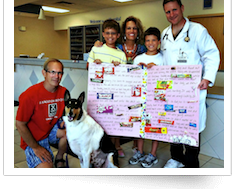Canine Parvovirus and Benefits of Plasma Treatment
Written by: Natasha D. • 2017 Scholar
INTRODUCTION
Canine parvovirus is a virus recognized in the 1970’s that has consistently trans-mutated into new virulent forms.5 CPV2 is one of the most common enteric pathogens seen in canines and predominantly infects neonates of the species.5 This infection is highly contagious and requires intensive care for the patient’s recovery which results in high fees for the owner and long term hospitalization and stress on the animal. A new potential treatment, canine plasma exposed to endotoxin, shows hope for reducing time, cost, and stress of infected animals. This plasma provides action against the virus in two new ways that can offer clinics a new option for owners with canine parvovirus infected animals.
EPIDEMIOLOGY
CPV, canine parvovirus, presented as one form, CPV2, when discovered. With time, the virus has mutated into multiple subsets: CPV-2A, CPV-2B, and CPV-2C.5 The newest form, detected in 2000 in Italy, is CPV-2C and is the most common illness seen in the U.S. Intensity of the illness depends upon two factors: viral dose and viral type.7 Structurally, CPV is non-enveloped virus and is highly contagious due to its stability.1 This infectious agent can survive 5-7 months in the environment and can potentially have virulence up to a year in soil. 6 CPV is shed through feces of the infected animal 4-5 post-infection and is transferred to animals by direct animal contact, contact with infected stools, environment, or people.6 The virus contaminates any physical surface: kennels, food/water bowls, collars/leashes, and hands/clothing of people who have handled the infected animal.6 Poor sanitation exuberates the rate of infection due to its hardy nature.7 This makes the rate of infection high and requires safety protocol for those who handle the animals, especially in clinics. Risk for infection is highest in unvaccinated dogs that are in close quarters such as dog breeders with new litters, boarding/kenneling situations, shelters, dog shows, and many other environments.6
PATHOPHYSIOLOGY
When an animal is infected with CPV, the virus travels to lymph nodes in the pharynx before it moves into the blood.1 This initial infection will present with lymphopenia, or low lymphocytes in the blood.7 This disorder always precedes physical findings presented by the sick animal. Once CPV is in the bloodstream, it will target actively dividing cells to be able to survive in the patient.7 These cells include: intestinal cells (crypt and villous cells), osteoblasts, and cardiac cells (cardiomyocytes and cardiac pace maker cells) in very young neonates.1 After infection, it only takes 3 days for the intestinal cells to be affected.7 Add one more day and the virus is actively shed in the stool of the sick canine.7 The shedding peaks once presentation of physical signs of the infection show.7 It is thought that one gram of CPV positive feces is concentrated enough to infect up to 10 million susceptible dogs.1 Day 8-12 post-infection, the amount of virus shed is no longer detectable.7 Intestinal cells consist of two types: crypt cells, which rapidly divide to replace old cells, and villous cells, which actively participate in absorption of electrolytes, water, and prevent fluid loss from the intestine into the stool. Once the virus destroys these cells, the intestinal mucosa is exposed and absorption of bacterial endotoxin will occur.7 The endotoxin damage results in the body producing a large amount of TNFa, a molecule which induces inflammation and apoptosis of infected cells. This inflammatory response can be overwhelming to the animals system and can be another factor that leads to further health deterioration. Normally, in vitro canine serum exhibits an anti-TNFa activity, but large volumes of TNFa can overwhelm this. If the dog’s body responds by producing too much TNFa, the dog’s serum natural anti-TNFa activity won’t stop the inflammatory process.3 Cells in the bone marrow are also another primary target for CPV. These cells produce red and white blood cells, which results in leukopaenia when infected with CPV.1 Leukopaenia means a decrease in white blood cells. This gives the virus an advantage in the young patient due to their immature adaptive immune system. It can easily reproduce due to the immune system not being able to respond to its presence. Furthermore, suppression of the immune system can lead to future infections: viral, fungal, or bacterial.5 Lastly, the cardiac cells are a target for animals in the first two weeks of their lives.1 The virus will affect the replication of these rapidly dividing cells which causes myocarditis. Sometimes, sudden death is associated with these canine neonatal infections but is no longer common due to vaccination.7
SYMPTOMS
The typical infected dog will present with a variety of physical signs. These symptoms include but are not limited to: anorexia, weight loss, dehydration, abdominal discomfort, severe hemorrhagic diarrhea, fluid-filled intestinal loops, enlarged lymph nodes, fever, vomiting, lethargy, congestive heart failure, cardiovascular shock, and sudden death.1&7
TREATMENT
Therapies in place for CPV are both symptomatic and supportive.7 The goal is to provide nutrition, restore electrolytes, maintain fluids, and resolve shock, sepsis, and endotoxemia, if present.7 This is achieved by hospitalizing patients and supplementing fluids with potassium chloride, due to loss of both electrolytes from intestinal cell damage.7 Fluids can also contain sodium bicarbonate if metabolic acidosis exists.7 If the animal won’t eat, an nasogastric tube can be implemented to do regular feedings to maintain glucose. Another option for anorexia is supplementing fluids with glucose. This maintains the blood sugar levels necessary for bodily function but does little nutritional support to the animal. It’s best to get the animal eating, even if in small amounts in the beginning. Antibiotic regime represents supportive care. Given prophylactically, bacterial infection will hopefully be avoided in the patient. A study investigated the correlation between CPV and Clostridial strains (C. perfringens and C. difficile). It showed a small percentage of concurrently CPV and bacterially infected dogs. More data is required to show strong evidence of synergism between enterotoxigenic bacterial strains predisposing dogs to CPV. If there is further proof in the future, antibiotics may be able to contribute to the elimination of the virus.
CANIPLAS E TREATMENT
A company recently emerged with a new form of treatment to decrease mortality rates of CPV. Plasvacc, an international company, produces “hyperimmunized blood products used to supplement the immune response system in animals” (CaniPlas E, 2012). One product, called Caniplas E, can be used in the treatment of dogs with endotoxaemia; working well with CPV infections.4 Furthermore, it specifically states: “Caniplas E can also be used to improve survival rates in dogs with canine parvoviral gastroenteritis when used in adjunct to traditional therapy” (Caniplas E, 2012). The company supports its product with studies. A 2006 study used canine hyperimmunized sera on cell bioassays of diluted TNFa concentrations. The outcome: enhanced anti-TNFa activity from the treated sera. This suggests that their product may have modulating effect on TNFa activated inflammatory cascades which could stop further damage of the patient’s body while enduring CPV infection.3 This can potentially prevent death from CPV, reduce recovery time, and reduce emotional and financial stress. Another 2007 study produced similar effects and used the plasma on in vivo animal models.2 Its mechanism works through TNFa receptor antagonist production. As cells die, TNFa is produced and binds to TNFa receptors, which corresponds with an increased inflammatory cascade. If these receptors are bound, TNFa has no further action. The cost for Caniplas E isn’t listed on PlasVacc’s website but with clinics adjusting the price for the plasma, it is a considerable option for owners who are dedicated to treating their CPV+ dog. Especially as the cost for the Caniplas E can compare, and maybe be less, to several days of hospitalization, treatment, and supportive care in a clinic.
Sources
- Judge, P. (2015). Management of the Patient with Canine Parvovirus Enteritis. Retrieved from http://www.nzvna.org.nz/site/nzvna/files/Quizzes/Parvo.pdf
- Kotiw, M., Morgan, M., Lopez, J., Taylor, S., Shiels, I. (2007). In vitro and in vivo determination of anti-TNFa activity in canine plasma from donors subject to preconditioning with endotoxin. Retrieved from http://plasvacc.com/cms/wp- content/uploads/pdf/research/CriticalCarePoster_Anti-TNF_RB2007.pdf
- Kotiw, M., Shiels, I., Reeve-Johnson, L., Wilson, R. (2006). In vitro effect of canine hyperimmune sera on TNFa activity. Retrieved from http://plasvacc.com/cms/wp- content/uploads/pdf/research/caninePLASMAinvitroJVPT2006.pdf
- Caniplas E. (2012). Retrieved August 10, 2017, from http://plasvacc.com/products/caniplas-e
- Silva, R., Dorella, F., Figueiredo, H., Costa, E., Pelicia, V., Ribeiro, B., Ribeiro, M., Paes, A., Megid, J., Lobato, F. (2017, December). Clostridium perfringens and C. difficile in parvovirus-positive dogs. Retrieved from http://www.sciencedirect.com.proxy.lib.iastate.edu/science/article/pii/S1075996417301440
- Schultz, R., Dr. (2007). Canine Parvovirus Type 2c FAQ. Retrieved from https://www.avma.org/public/PetCare/Pages/Canine-Parvovirus-FAQs.aspx
- Tilley, LP, Smith, FWK. (2016). Blackwell’s Five Minute Veterinary Consult: Canine and Feline (6th Ed.). Wiley Blackwell, John Wiley and Sons, Inc. p. 216-217.




